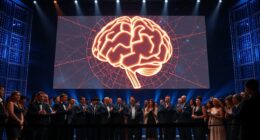We are currently investigating the challenges of integrating intelligent tutoring systems in the classroom.
Limited teacher training and support, lack of student engagement and motivation, integration with existing curriculum and resources, access to technology and infrastructure, and data privacy and security concerns are all on the table.
Join us as we explore these obstacles and uncover strategies for overcoming them.
Let’s embark on this journey towards a liberated and empowered education system.

Key Takeaways
- Insufficient teacher training hampers integration of intelligent tutoring systems.
- Low student engagement and motivation hinder the effectiveness of intelligent tutoring systems.
- Seamless integration requires alignment with the existing curriculum and resources.
- Equal access to technology and infrastructure is crucial for integration.
Limited Teacher Training and Support
We have noticed a significant lack of sufficient teacher training and support when it comes to integrating intelligent tutoring systems in the classroom.
Teacher preparation is crucial for successful implementation strategies of these systems. However, many educators aren’t adequately trained on how to effectively utilize these tools to enhance student learning.
This lack of training limits their ability to fully harness the benefits of intelligent tutoring systems. Without proper support, teachers may struggle to integrate these systems seamlessly into their instruction, leading to ineffective implementation.
To address this challenge, it’s imperative that schools and districts prioritize comprehensive teacher training programs that provide educators with the necessary knowledge and skills to effectively integrate intelligent tutoring systems.

Lack of Student Engagement and Motivation
One major challenge that arises when integrating intelligent tutoring systems in the classroom is a lack of student engagement and motivation. This issue can hinder the effectiveness of these systems and limit the potential learning outcomes.
To tackle this challenge, educators can employ various pedagogical strategies and gamification techniques. Here are four ways to enhance student engagement and motivation:
-
Personalize Learning: Tailoring the content and pace of instruction to individual students’ needs can increase their interest and engagement.
-
Provide Instant Feedback: Offering immediate feedback on student performance helps them understand their progress and motivates them to improve.

-
Incorporate Gamification Elements: Gamifying the learning experience by adding elements such as rewards, badges, and leaderboards can make it more enjoyable and engaging for students.
-
Foster Collaboration and Competition: Encouraging collaboration and friendly competition among students can create a sense of excitement and motivation to excel.
Integration With Existing Curriculum and Resources
To successfully integrate intelligent tutoring systems in the classroom, we must consider how they can be seamlessly incorporated into existing curriculum and resources.
Curriculum alignment is crucial to ensure that the tutoring system complements and enhances the learning objectives of the curriculum. By aligning the content and activities of the system with the curriculum, teachers can provide targeted support to students and reinforce the concepts taught in class.

Additionally, resource compatibility is essential for a smooth integration process. The tutoring system should be able to integrate with existing educational resources, such as textbooks, online platforms, and learning management systems. This compatibility allows for a cohesive learning experience, where students can easily access and utilize various resources to enhance their understanding.
Access to Technology and Infrastructure
How can we ensure access to technology and infrastructure for integrating intelligent tutoring systems in the classroom? In order to bridge the digital divide and overcome technological barriers, we must address the following:
-
Equitable distribution: It’s crucial to ensure that all students have equal access to technology and infrastructure, regardless of their socioeconomic background.
-
Affordability: Making technology and internet connectivity affordable and accessible to all students can help minimize the digital divide and allow for the integration of intelligent tutoring systems.

-
Infrastructure development: Investing in robust and reliable infrastructure, such as high-speed internet and up-to-date hardware, is essential for seamless integration of intelligent tutoring systems.
-
Teacher training and support: Providing comprehensive training and ongoing support to teachers can empower them to effectively utilize technology and integrate intelligent tutoring systems into their classrooms.
Data Privacy and Security Concerns
As we delve into the subtopic of data privacy and security concerns, it is important to address the potential risks and safeguards associated with integrating intelligent tutoring systems in the classroom. Data governance plays a crucial role in ensuring the protection of student information. Schools must establish clear policies and guidelines for collecting, storing, and using student data. Ethical implications also arise when considering the use of intelligent tutoring systems. It is essential to prioritize the privacy and consent of students and their families. To provide a clear overview of the risks and safeguards, we have created a table below:
| Potential Risks | Safeguards | Ethical Implications |
|---|---|---|
| Unauthorized access | Strong data encryption and access controls | Privacy and consent |
| Data breaches | Regular security updates and monitoring | Data protection |
| Misuse of student data | Strict data access policies and training | Student rights |
| Lack of transparency | Clear communication and informed consent | Accountability |
| Bias in data analysis | Regular audits and diversity training | Fairness and equity |
Frequently Asked Questions
How Can Teachers Effectively Integrate Intelligent Tutoring Systems Into Their Classroom Without Sufficient Training and Support?
Teachers can effectively integrate intelligent tutoring systems into their classroom without sufficient training and support by seeking teacher support and identifying their training needs. This helps ensure successful implementation and utilization of these systems for student learning.

What Strategies Can Be Used to Increase Student Engagement and Motivation When Using Intelligent Tutoring Systems?
To increase student engagement and motivation when using intelligent tutoring systems, we can employ strategies like incorporating interactive elements and gamification, providing personalized feedback, and fostering a collaborative learning environment.
How Can Schools Ensure That the Integration of Intelligent Tutoring Systems Aligns With Their Existing Curriculum and Resources?
To ensure alignment with our existing curriculum and optimal resource utilization, we must carefully integrate intelligent tutoring systems. This requires thorough evaluation, collaboration between educators and developers, and strategic planning to address any potential challenges.
What Steps Can Be Taken to Address the Issue of Limited Access to Technology and Infrastructure in Implementing Intelligent Tutoring Systems?
Addressing infrastructure challenges and overcoming technology barriers requires a comprehensive approach. We can start by advocating for increased funding, providing training for teachers, and exploring alternative options like mobile devices or community partnerships.
What Measures Can Be Put in Place to Ensure Data Privacy and Security When Using Intelligent Tutoring Systems?
How can we ensure data privacy and security when using intelligent tutoring systems? What measures can be put in place to protect data and safeguard against cybersecurity threats?

Conclusion
In conclusion, the integration of intelligent tutoring systems in classrooms presents a myriad of challenges that must be addressed. These challenges include limited teacher training and support, a lack of student engagement and motivation, the need to integrate with existing curriculum and resources, access to technology and infrastructure, and concerns regarding data privacy and security.
It’s imperative that educators and policymakers work together to find solutions that promote effective and seamless integration of these systems while addressing these complex issues.











